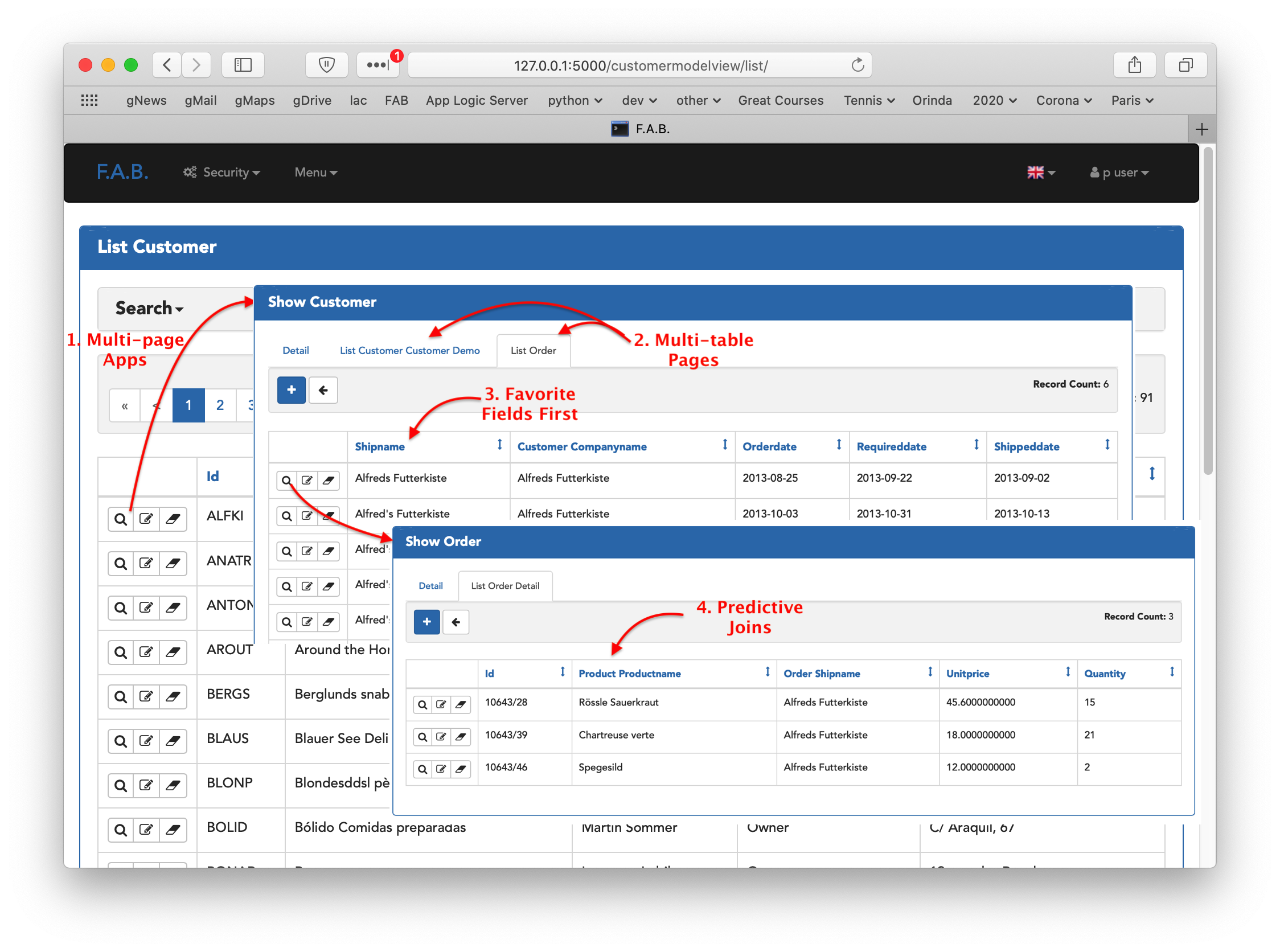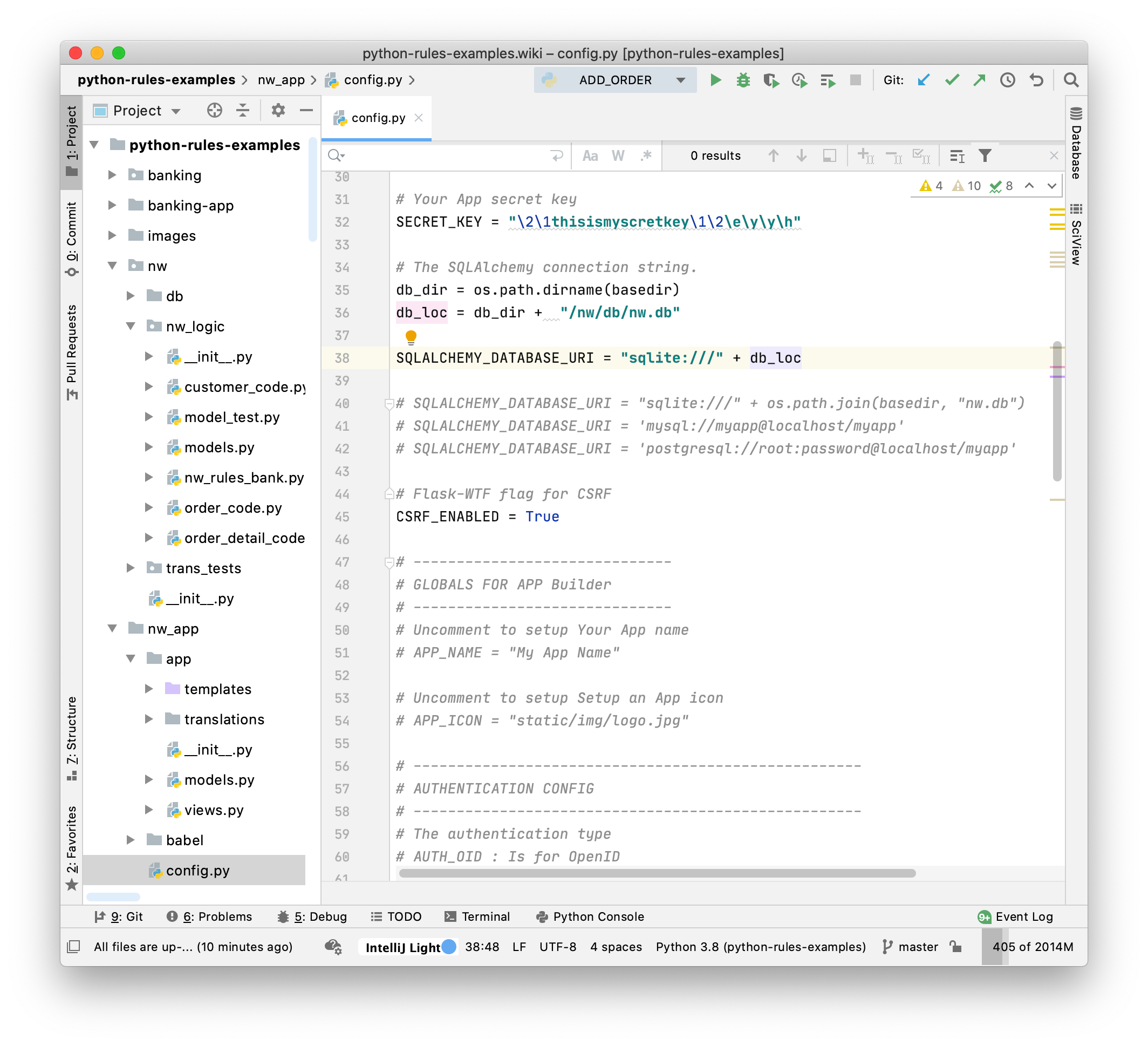This project is a complement to python-rules,
which explains the concepts of rules, as well being used for
development of python-rules.
Here we focus on the practicalities of installation and configuration, with 2 (unrelated) samples:
nw(same as in python-rules)banking
This page shows the common install / configure tasks common to both. In both cases, they use fab-quickstart, which is optional but recommended since it makes it really easy to explore your database.
You can install this pre-configured example as described below.
To get started, you will need:
-
Pythonv3.8 (Relies on
from __future__ import annotations, so requires Python 3.8)- Run the windows installer; on mac/Unix, consider using brew
-
virtualenv - see here (e.g.,
pip install virtualenv) -
An IDE - any will do (I've used PyCharm and VSCode, install notes here), though different install / generate / run instructions apply for running programs.
Issues? Try here.
Using your IDE or command line:
# fork https://github.com/valhuber/python-rules-examples.git -> yourname
git clone https://github.com/yourname/python-rules-examples.git
cd python-rules-examples
virtualenv venv
source venv/bin/activate
(venv)$ pip install -r requirements.txt
Either in your IDE or the command line, you can run tests and examine the logs that depict logic execution and chaining:
(venv)$ cd nw/trans_tests
(venv)$ python upd_order_reuse.py
You can also run the pre-created fab application:
(venv)$ cd ../../nw_app
(venv)$ export FLASK_APP=app
(venv)$ flask run
Start your browser here, login as admin, p.
This project has already been set up. Here's how we did it.
We'll be using nw as an example.
# create your project root (check this into scs)
mkdir nw
cd nw
virtualenv venv
# configure SCS to ignore venv
# windows .env\Scripts\activate
source venv/bin/activate
(venv)$ pip install -i https://test.pypi.org/simple/ python-rules
(venv)$ pip install SQLAlchemy
(venv)$ pip install sqlacodegen
# if using fab
(venv)$ pip install flask-appbuilder
(venv)$ pip install fab-quick-start
We'll recreate the python-rules-examles.
We'll follow the same structure to make things definite,
so you can compare.
Of course, use whatever structure you like,
here's how we did it for nw and banking:
# in nw...
(venv)$ mkdir nw_logic
(venv)$ mkdir db
There are many ways to create models.
- You can create the models file by hand, and use that to generate the database, or
- You can use an existing database, and create a models file to match it.
For existing databases, consider using
sqlacodegen.
Here, we'll use nw as our example;
we already have a sqlite database in our nw/db folder
(download a copy) so:
(venv)$ cd db
(venv)$ sqlacodegen sqlite:///nw.db --noviews > nw/nw_logic/app/models.py
(venv)$ sqlacodegen sqlite:///Northwind_small.sqlite --noviews > ../nw_logic/models.py
The first parameter identifies your database location; consult the sqlacodegen documentation.
Both python-rules and fab-quickstart depend on
relationships. Ideally, they exist in your database,
in which as sqlcodegen will find them. If that's
not practical, SQLAlchemy also lets to define them in your models:
- declare the foreign keys, eg, Orders has a foreign key to customers
CustomerId = Column(ForeignKey('Customer.Id'))
- declare the references in the parent (not child), eg, declare orders
for customer like this
OrderDetailList = relationship("OrderDetail", backref="OrderHeader", cascade_backrefs=True)
To illustrate, let's use an adaption of the Northwind database, with a few rollup columns added. For those not familiar, this is basically Customers, Orders, OrderDetails and Products, as shown in the diagrams below.
Logic is declared as spreadsheet-like rules as shown below
from nw/nw_logic/nw_rules_bank.py,
which implements the check credit requirement:
def activate_basic_check_credit_rules():
""" Check Credit Requirement:
* the balance must not exceed the credit limit,
* where the balance is the sum of the unshipped order totals
* which is the rollup of OrderDetail Price * Quantities:
"""
Rule.constraint(validate=Customer, as_condition=lambda row: row.Balance <= row.CreditLimit,
error_msg="balance ({row.Balance}) exceeds credit ({row.CreditLimit})")
Rule.sum(derive=Customer.Balance, as_sum_of=Order.AmountTotal,
where=lambda row: row.ShippedDate is None) # *not* a sql select sum
Rule.sum(derive=Order.AmountTotal, as_sum_of=OrderDetail.Amount)
Rule.formula(derive=OrderDetail.Amount, as_expression=lambda row: row.UnitPrice * row.Quantity)
Rule.copy(derive=OrderDetail.UnitPrice, from_parent=Product.UnitPrice)To test our rules, we use
nw/trans_tests/add_order.py.
It activates the rules using this import:
from nw.nw_logic import session # opens db, activates logic listener <--This executes nw/nw_logic/__init__.py,
which sets up the rule engine:
by_rules = True # True => use rules, False => use hand code (for comparison)
if by_rules:
rule_bank_setup.setup(session, engine) # setup rules engine
activate_basic_check_credit_rules() # loads rules above
rule_bank_setup.validate(session, engine) # checks for cycles, etc
else:
# ... conventional after_flush listeners (to see rules/code contrast)Python Flask Application Builder (fab) creates "basic" applications for database crud operations quickly, with minimal coding. Typical fab pages can look like this:
- Multi-page: apps include 1 page per table
- Multi-table: pages include
related_viewsfor each related child table, and join in parent data - Favorite field first: first-displayed field is "name", or contains "name" (configurable)
- Predictive joins: favorite field of each parent is shown (product name - not the foreign key
product_id_) - Ids last: such boring fields are not shown on lists, and at the end on other pages
Create a default empty FAB app:
# cd to nw folder
(venv)$ flask fab create-app
You will then be prompted for the project name and your db engine type. When prompted:
- Use the default engine
- Name the project
nw_app
You should see a structure as shown in the screen shot in the next section.
We now have a well-formed empty project. We now need to acquire and configure a database, set up SQLAlchemy ORM models.py, and define our pages with views.py.
Update your nw-app/config.py file to denote this database name (illustrated below).
Your project will look something like this:
FAB requires that we edit 2 key files to make our "empty" project interact with the database. These can get tedious, due to per-page code required for each table / page. For more information, see here.
The following sections show how to use generators to avoid the tedious hand creation of the views.py and the models.py files.
We have already created our models.py file.
However, it has not been been discovered how to use it,
so copy the models.py to your nw/app folder.
Finally, we need to define some pages. That's also a bit of work to do that by hand, so let's use fab-quick-start
to create the views.py file from the app/models.py file (hit enter to accept defaults when prompted):
(venv)$ fab-quick-start run --favorites="name description" --non_favorites="id" > app/views.py
This overwrites your nw/nw-app/app/views.py file. For more information, see the FAB Quick Start Utility docs.
The FAB system can create tables in your database for authenticating and authorizing users (tables such as ab_user, ab_user_role, etc). You create these as follows (Username: admin, Password: p):
(venv)$ export FLASK_APP=app
(venv)$ flask fab create-admin
Username [admin]:
User first name [admin]:
User last name [user]:
Email [admin@fab.org]:
Password:
Repeat for confirmation:
Ignore the error "user already exists", since the admin data was pre-loaded.
You can verify your data and admin data like this (mac/unix only):
sqlite3 nw.db # mac only
> .tables
> .schema Order
> select * from ab_user;
> select * from Territory;
> .quit
You've now created a app with a dozen pages or so; run it like this:
(venv)$ # still cd'd to nw-app
(venv)$ export FLASK_APP=app
(venv)$ flask run
Start your browser here.
nw running, banking under development

